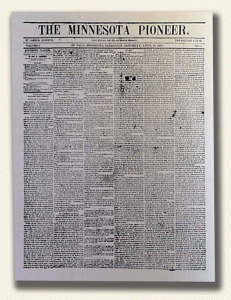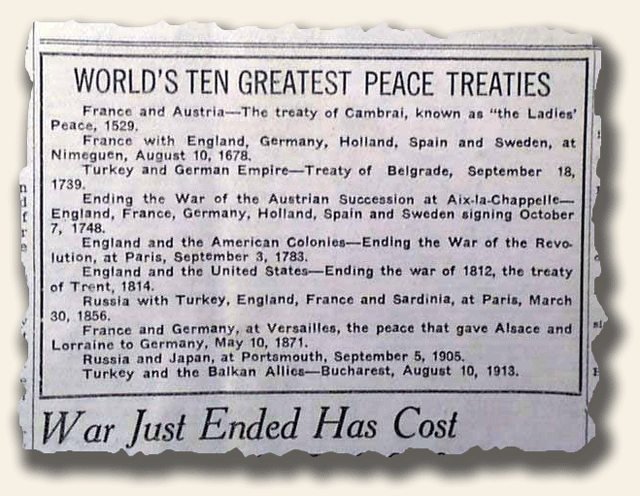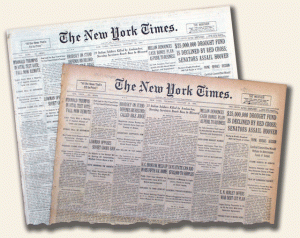Post-Boys from London… A collector asks…
June 12, 2015 by GuyHeilenman · Leave a Comment
The following is a guest post from a collecting friend. Feel free to weigh-in on any of his questions or comments:
“While I have been buying newspapers for 10 years [from Rare Newspapers], I have yet to see numbers of estimates printed for the popular London Post-Boy (most of my collection is the Post-Boy). Over the years, I have not found any numbers on the web until just this week! I was again urged on my watching Art and Coin TV, in which the 1899 Morgan Silver Dollar for sale, was mentioned to be very rare, with only 300,000 minted! Ha!
In the publication ‘Publishing Business in Eighteenth-Century England’, by James Raven, he states surviving records list the thrice-weekly printing in 1704 was 9000 a week, so 3000 per date! Quite a bit less then Morgan dollar for sure. But what of the total numbers that survive today?
My best guess would be at most, 1-2 percent of any one date, under 100 copies held in intuitions and private hands? Any one here found any estimates published on surviving copies? As an off-set pressman by trade, I enjoy showing off the Post-Boy at work, to the delight of all.”
Lawrence Garrett
Follow-up from Lawrence:
“I know a phrase from a London Gazette I have been trying to fully understand, without success. {It is found within] a September 24, 1666 issue you have. It states a ship ‘struck on the sands of the riff-raffes’. This sounds like a Sandbar, but I have seen sandbars called just that in these old newspapers. Despite much research, I cannot find any slang term for sandbars from any time period, let alone 1666. It would be nice to find published information confirming these Riff-Raffes are indeed sandbars. Is it possible these sea/lake/river bottom features were called Riff-Raffes BEFORE land use for rough trouble making people? Any other readers found this in other newspapers?”
Minnesota’s first newspapers…
June 21, 2010 by TimHughes · 3 Comments
 The first “Minnesota” newspaper has the curious distinction of never being printed in Minnesota. Dr. Andrew Randall, a U.S. government employee from Ohio engaged in a geological survey of the Minnesota district, decided to become a printer. He returned to his home town of Cincinnati, purchased printing equipment, and produced in Cincinnati the volume 1, number 1 issue of the “Minnesota Register“. There was but one number, but existing copies bear different dates of April 7 and 27, 1849.
The first “Minnesota” newspaper has the curious distinction of never being printed in Minnesota. Dr. Andrew Randall, a U.S. government employee from Ohio engaged in a geological survey of the Minnesota district, decided to become a printer. He returned to his home town of Cincinnati, purchased printing equipment, and produced in Cincinnati the volume 1, number 1 issue of the “Minnesota Register“. There was but one number, but existing copies bear different dates of April 7 and 27, 1849.
Another outsider, James Goodhue, a lawyer-turned printer from Lancaster, Wisconsin, worked for a newspaper in Wisconsin before carting his equipment and heading north for St. Paul’s Landing in the Minnesota Territory. There he planed on printing what was to be named the “Epistle of St. Paul”, but after advice of friends the first issue was actually titled the “Minnesota Pioneer“, appearing on April 28, 1849. Not only was this the first newspaper actually printed in Minnesota, it was the first piece of any printing done in the territory.
The next newspaper was done by another Ohioan, James Hughes, who on May 31, 1849 printed the “Minnesota Chronicle” on May 31, 1849. Third in line was the “Minnesota Register“, now moved from Cincinnati to Minnesota to become a legitimate Minnesota newspaper when it printed its July 14, 1849 issue in St. Paul. Just over a month later the “Chronicle” and “Register” combined to produce the “Chronicle & Register” on August 25.
Rare Newspapers – distracting?
May 6, 2010 by GuyHeilenman · 2 Comments
One of the most common questions our Rare Newspapers’ staff is asked is, “How do you ever get anything done? Don’t you get distracted by the interesting content within the issues?” The answer is an enthusiastic, “YES!” One of the most enjoyable aspects of our daily interaction with early newspapers are these very “distractions”. Hardly a day goes by where we aren’t fascinated by or engaged in conversation resulting from the content within the issues we find.
One such discussion (distraction) was recently inspired by an issue of the Omaha Daily Bee dated June 28, 1919, which originally caught our attention because of its dramatic WWI headline, “PEACE TREATY SIGNED”, with a corresponding subhead, “China Alone Refuses To Sign Covenant That Ends Greatest War in History”. However, what caused our “distraction” was the front page text (shown in the image) regarding the “World’s Ten Greatest Peace Treaties“. Although this issue is no longer available, it can be viewed at: http://www.rarenewspapers.com/view/570082?acl=781584385. Much has occurred since the early 20th century. We wonder what such a list might include if it were printed on the front page of a tomorrow’s newspaper?
Old news is good news for collectors…
November 19, 2009 by GuyHeilenman · Leave a Comment
 David Chesanow recently interviewed Timothy Hughes for a post at Americollector.com titled, “Old news is good news for collectors”. Some of the questions asked were:
David Chesanow recently interviewed Timothy Hughes for a post at Americollector.com titled, “Old news is good news for collectors”. Some of the questions asked were:
- What newspapers do you yourself collect: ones from a specific region or era or pertaining to a certain subject? Or are newspapers in general your collecting “area” and you just like the rarest, most historic items?
- What are the collecting areas within the hobby?
- What are some of the interesting collecting areas of some of your customers?
- How extensive is the hobby of collecting rare newspapers? Are there any other dealers at all who specialize in this?
- What are the “Holy Grails” of newspaper collecting?
- Are newspapers ever forged? For example, aren’t there a lot of professionally done reprints in England?
- What have newspapers been made of over the years, and how perishable are they? Are the high-acid papers necessarily hard to preserve?
- When was the transition from rag content to high-acid paper in the U.S. and abroad?
- AND… many more!
The entire post is available for viewing at: Americollector.com. Thank you David for your contribution to the collectible.
“Telegraph” newspapers prior to 1844?
July 20, 2009 by TimHughes · Leave a Comment
 It is commonly known that the magnetic telegraph was developed in 1844 by Samuel Morse, so perhaps you’ve wondered—like I have—why so many newspapers had the title “Telegraph” dating long before this date? Clarence Brigham in his book “Journals & Journeymen” provides some details.
It is commonly known that the magnetic telegraph was developed in 1844 by Samuel Morse, so perhaps you’ve wondered—like I have—why so many newspapers had the title “Telegraph” dating long before this date? Clarence Brigham in his book “Journals & Journeymen” provides some details.
Between 1792 & 1794 several systems of telegraphic signals were developed in England & France. They were dependent upon cross-bars pivoting into difference positions at the top of high poles.
In 1795 a paper was established at Carlisle, Pennsylvania, titled “The Telegraphe”. The first issue did a history of telegraphic experiments taken from British & French periodicals, & stated it was the first paper in America to use the title. This was true, but less than a month after the Carlisle paper’s beginning the “Fells Point Telegraphe” was established at Baltimore, and shortly thereafter newspapers in Charleston, Greenfield (Mass.), and again in Baltimore changed their titles to include the word “Telegraphe”. In the next five months another 4 newspapers incorporated this word into their titles.
By 1820 forty newspapers in America had employed this word into their mastheads, but the phenomena was almost entirely American. Curiously only 2 papers in London & Paris used the word in 1794 and none after that until later in the 19th century.
An early attempt at preserving newspapers…
July 6, 2009 by TimHughes · 2 Comments
 You may have noted many of our descriptions of the New York Times from the 1927-1953 period are described as the “rag edition”.
You may have noted many of our descriptions of the New York Times from the 1927-1953 period are described as the “rag edition”.
Fellow collector Paul Sarna passed along the following information taken from “News-Week” magazine of Oct. 28, 1933. It’s an interesting report from 76 years ago of the creation of the “rag edition” as a means of preserving newspapers for posterity, which remain a concern for present-day institutions as well.
A brief piece from this 1933 magazine tells of its beginning:
“To preserve valuable newspapers, libraries from time to time have resorted to sprays, rejuvenators, and glassine covers. But none has been to successful. With an eye on this problem the New York times, in 1927, began printing an edition on enduring rag paper. the idea had two disadvantages: the subscription price of the rag edition was $170 annually, and it filled about 870 ft. of new shelf space each year.”
The rag edition was produced on a very high quality newsprint, with a high percentage of cotton & linen content allowing the issues to remain very white & sturdy many years into the future. Given the subscription cost it is not surprising that libraries rather than individuals were the primarily subscribers. We have never seen a never-bound rag edition of the Times although they might exist.
The Times discontinued the rag edition in 1953. A few other newspapers also produced a rag edition during the early part of the 20th century as we’ve encountered a run of Detroit News in rag edition. Is anyone aware of other titles?


